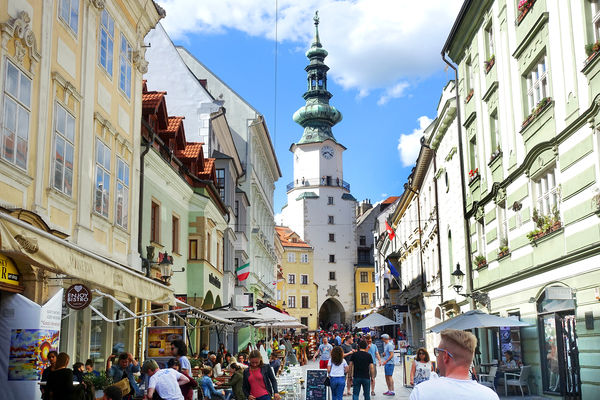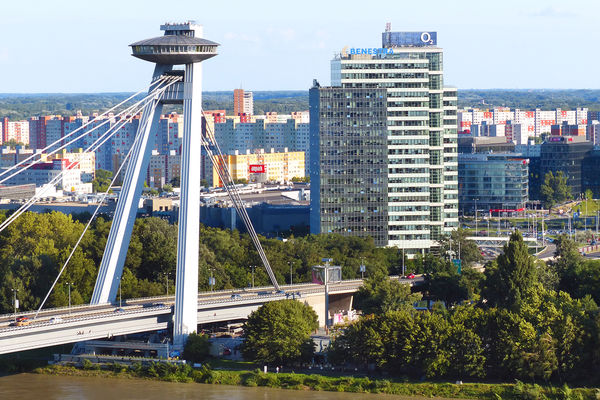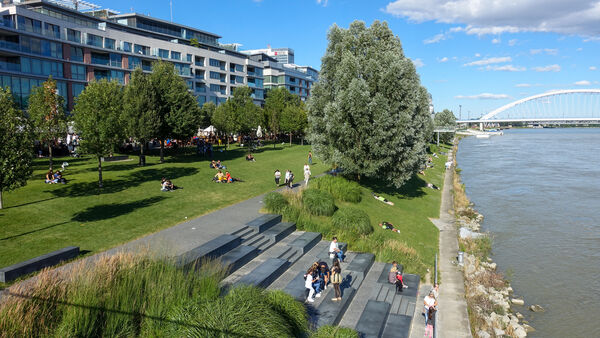Bratislava: Slovakia’s Capital Makes a Remarkable Comeback
By Rick Steves


Bratislava, the capital of Slovakia and once a nearly desolate ghost town, is one of Europe's great urban success stories. Its compact old town bursts with colorfully restored facades, lively outdoor cafés, and swanky boutiques. Its ramshackle industrial quarter, just east of the center, is rapidly being redeveloped into a forest of skyscrapers. The hilltop castle gleams. And even the glum communist-era suburb of Petržalka, right across the Danube, has undergone a Technicolor makeover. It's arguably the fastest-changing city in Europe.
Sitting quietly in the very center of central Europe, wedged between bigger and stronger nations (Hungary, Austria, the Czech Republic, and Poland), Slovakia was brutally disfigured by its communist regime, then overshadowed by the Czechs. But in recent years, this fledgling republic has found its wings. Locals brag that the region around Bratislava has the hottest economy and highest per capita income of any region in the former Communist bloc.
Bratislava has also forged a twin-city alliance for trade and commerce with Vienna — which is less than an hour's train ride away, and whose lights you can sometimes see from here — making this truly the nexus of eastern central Europe.
Many Bratislavans fancy themselves the yang to Vienna's yin: If Vienna is a staid, elderly aristocrat sipping coffee, then Bratislava is a vivacious young professional jet-setting around Europe. Bratislava at night is a lively place, thanks in part to tens of thousands of university students.
Though lacking blockbuster sights (you could easily have a great day here without paying a single admission fee), Bratislava is made for strolling. If you have just a few hours to spend, head straight to the old town and wander its mostly traffic-free streets, finishing with one or more of the city's fine viewpoints: Ascend to the observation deck atop a funky bridge or hike up to the castle for the views. With more time, stroll along the Danube riverbank to the thriving, modern Eurovea development — essentially a riverside park with luxury condos and a modern shopping mall. Enjoying a drink in one of its chic outdoor lounges, you'll get a glimpse of where Slovakia is heading.
From the end of World War II until Czechoslovakia's Velvet Revolution in 1989, Bratislava was a damaged husk. The communist regime had no respect for the town's heritage, selling off the old town's medieval cobblestones to cute German towns rebuilding after the war. Locals avoided this stripped-down, desolate corner of the city, preferring to spend time in the Petržalka suburb across the river.
With the collapse of the communist regime, the new government began returning buildings to their original owners and over time, the city made the old town traffic-free, spruced up public buildings, and encouraged private owners to restore their buildings as well. Life has returned with a vengeance and Bratislava's old-town charm is on full display.
Most visitors first encounter this charm via St. Michael's Gate, which is topped by the last surviving tower of the medieval city walls. It leads to the delightful Michalská Street, crammed with cafés and boutiques, and a symbol of how far the city has come. The town's modest main square, Hlavné Námestie, feels too petite for a national capital. Its style is a mishmash — every building around it seems to date from a different architectural period. Elsewhere in the old town, you'll find the Old Market Hall, which dates back to 1910, and is now a busy community center that hosts concerts and a Saturday market. Laurinská Street is Bratislava's fashion drag, lined with fun-to-browse boutiques. And look out for the many whimsical statues that dot the old town. Most date from the late 1990s, when city leaders wanted to entice locals back into the newly prettied-up and fun-loving center.
Imposing Bratislava Castle is the city's most prominent landmark. Habsburg Empress Maria Theresa transformed the castle in the 18th century from a military fortress to a royal residence. Big and iconic as it is, frankly it's dull up close — and the exhibits inside are not too exciting. Still, it's almost obligatory to head up for the views, especially as it's surrounded by a delightful public park.
Spanning the nearby river, just downhill from the castle, is the huge flying-saucer-capped SNP Bridge, the communists' pride and joy. ("SNP" is shorthand for the 1944 Slovak National Uprising against the Nazis, a common focus of communist remembrance.) Locals aren't crazy about this structure — not only for its questionable Starship Enterprise design, but also because of the oppressive regime it represented. However, it's been reclaimed by capitalists, and the restaurant and observation deck have been renovated into a posh eatery called "UFO."
I admit that Bratislava used to leave me cold. But changes in recent decades have transformed it into a delightful destination. Bratislava's energy is inspiring.

